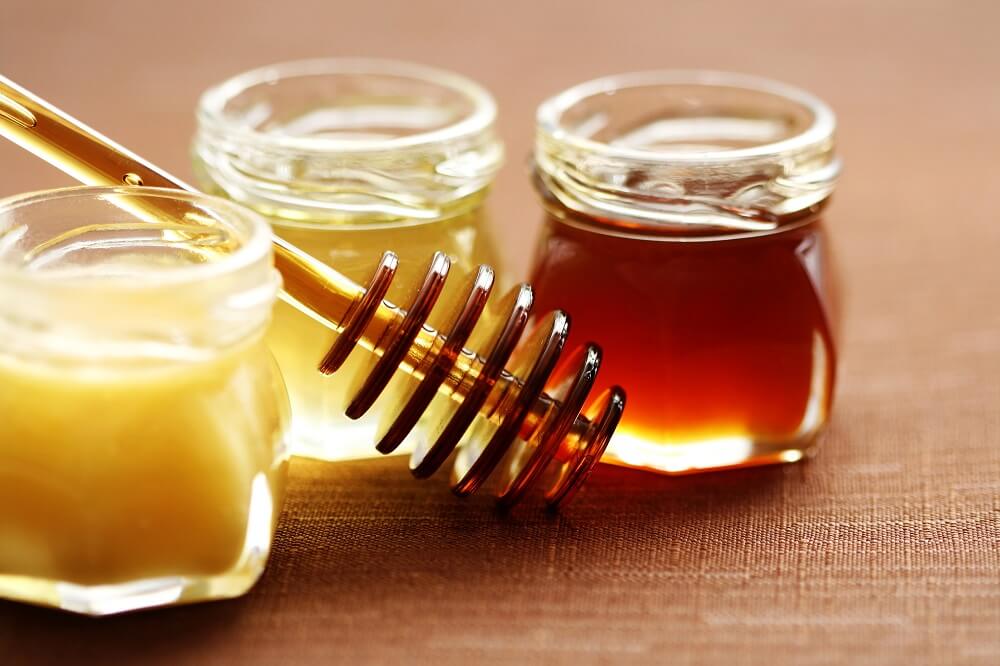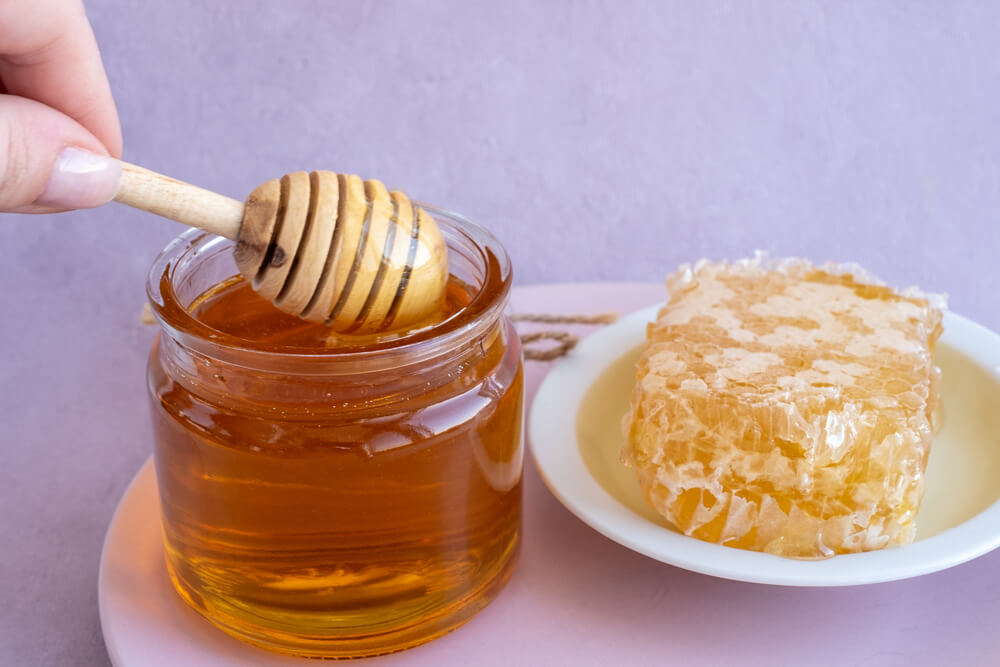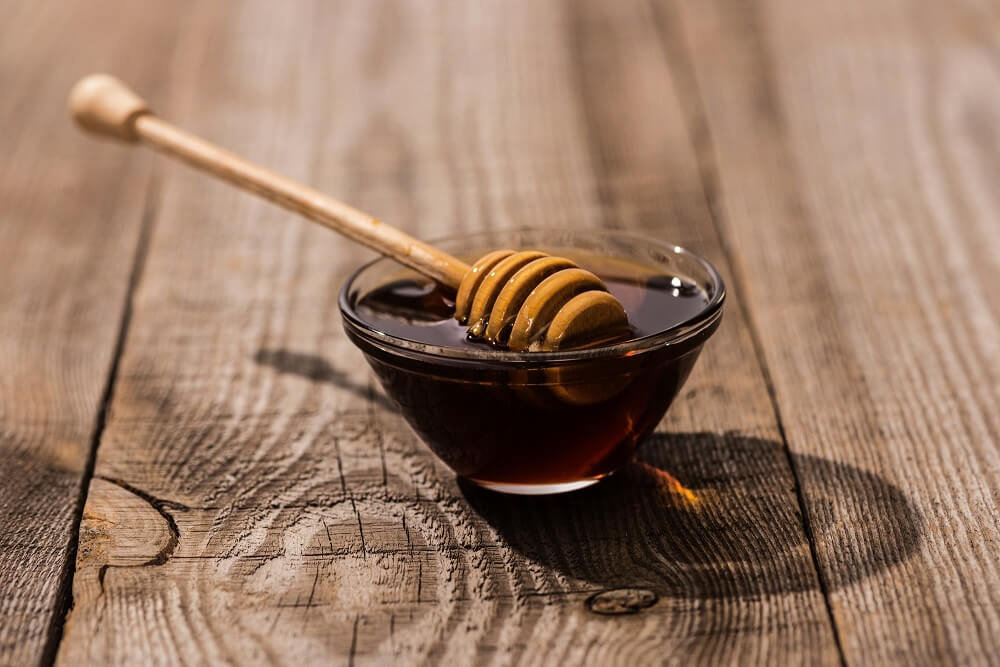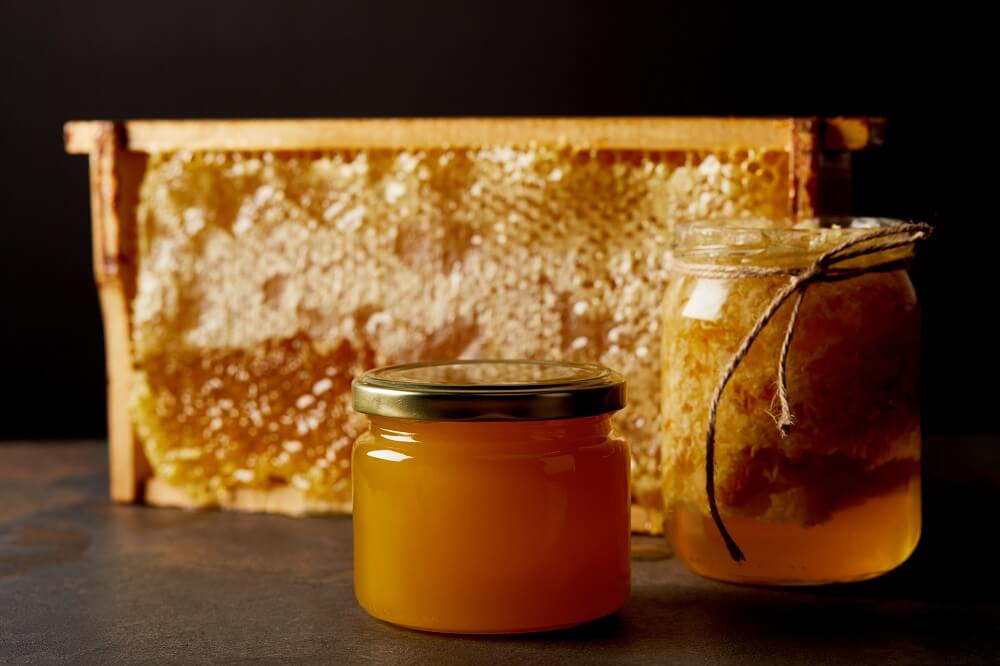Want to hear something surprising?
There are more than 300 unique types of honey.(1)
Yup, you read that right.
This means bees are hard at work pollinating flowers from different sources. In fact, it takes 12 worker bees to produce a single teaspoon of honey.
Crazy, right?
But now that begs the question:
Which Type of Honey is the Best?
Let’s start at the beginning.
There are two common types of honey:
- Filtered honey
- Unfiltered honey

What’s the difference, you ask?
Well, raw and unfiltered honey is chock-full of antioxidants, minerals, and enzymes.
And the taste?
It’s incredible.
Filtered honey is completely different.
You see, when honey goes through heavy filtering and heating, it gets stripped of its nutritional value. This means it loses the skin and health benefits that make honey special. Plus, filtered honey doesn’t have that amazing flavor that raw and unfiltered honey does.
Even worse?
An estimated 76% of grocery store honey is filtered and processed, according to Food Safety News.(2)
So the bottom line is this:
Raw and unfiltered honey is the best type of honey you can buy.
That’s why the FDA has released a statement saying ultra-processed honey is no longer considered real honey. Because not only is all the good stuff filtered out, but additives like high fructose corn syrup are added in.(3)
No bueno.
So when you’re shopping for honey, make sure the label says “raw and unfiltered.”
Still with me?
Good.
Let’s jump into the best types of honey flavors.
Related: What is Beeswax?
The 3 Most Popular Types of Honey With Pictures
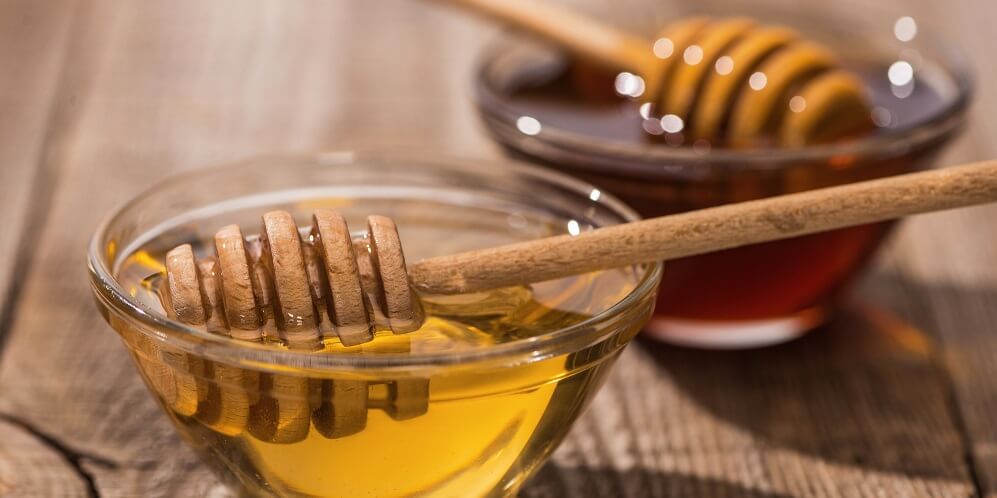
Most Popular Type of Honey: Clover
The winner is in.
Clover honey is the most popular type of honey on the market.
This honey comes from bees who pollinate clover plants. Clover plants are weather-hardy, so they’re a preferred nectar source for honey bees.(4, 5)
What’s so special about clover honey, though?
It’s famous for its sweet, slightly floral taste. This makes it a delicious choice in warm tea or drizzled over food. I keep a backup bottle of clover honey so that I don’t run out.
Clover honey varies in color from white to light amber.
Some Benefits of Clover Honey:
- It’s good for your skin because it’s antibacterial and antiviral. In clinical settings, honey has been shown to help reduce inflammation and heal wounds.(6, 7, 8)
- Clover honey is regularly used in cold and cough medicines. It’s been shown to be more effective at soothing sore throats than some popular cough medications.(9, 10, 11)
- Clover honey is full of antioxidants that help protect your cells against cancer and many types of diseases.(12, 13, 14, 15)
Our Clover Honey Pick:
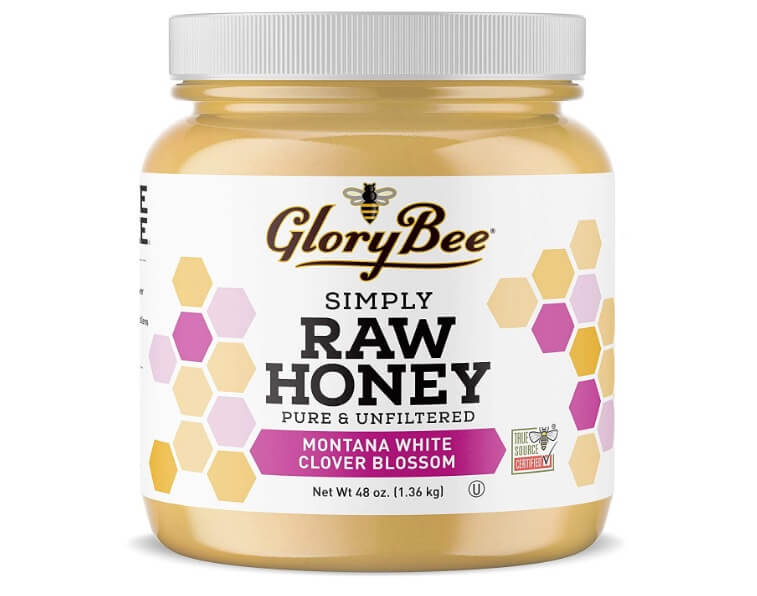
The flavor of this honey will knock your socks off. It’s smooth and buttery, so it pairs well with just about anything. I love putting it on toast with a sprinkle of cinnamon. Incredible! It’d also go good with peanut butter and honey sandwiches. Once you try this raw and unfiltered clover honey, you’ll never go back to the processed stuff. I especially love that a portion of the sales go to the Save-The-Bee Foundation.
Second Most Popular Type of Honey: Manuka
Manuka honey comes from bees that pollinate the manuka plant, also known as Leptospermum scoparium.
I’ll shoot straight with you.
Manuka honey isn’t as outright sweet as other types of honey. It has a nice, medium sweetness and a slightly earthy/nutty flavor to it.
It varies in color from medium golden to dark amber.
What’s so special about manuka honey?
The health benefits.
This honey is truly a powerhouse that packs a punch. I’ve used it to treat upper respiratory infections, heal wounds, and give me energy during my long workdays.
(Side note: Feel free to check out our list of the best manuka honey brands.)
Some Benefits of Manuka Honey:
- The FDA has approved manuka honey as an option for wound treatment. Multiple studies show that it enhances skin’s healing, accelerates the regeneration of tissue, and even decreases pain in patients suffering from burns.(16, 17, 18)
- You can promote better oral health through manuka honey. Studies show that manuka honey treats harmful bacteria associated with plaque formation, gum inflammation, and tooth decay.(19, 20, 21)
- Manuka honey helps with digestion. It’s been proven to improve antioxidants and decrease inflammation in rats with both IBS and ulcerative colitis.(22)
Our Manuka Honey Pick:
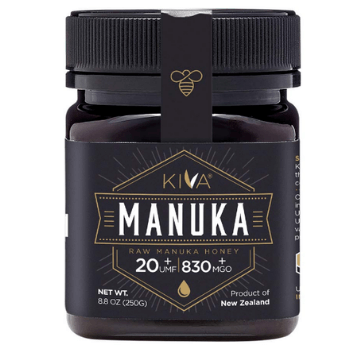
The consistency of this honey is silky smooth and tastes delicious. It’s pricey compared to other types of honey, but it’s because it’s full of antioxidants, enzymes, and other nutrients. The health benefits of manuka honey are incredible. For example, I used it after suffering from a severe upper respiratory infection that kept me up all night coughing. After two days of taking this honey, my symptoms were gone completely. It cleared up my congestion and reduced the hoarseness in my voice. Since then, I’ve kept a bottle of this on hand for cold and flu season.
Third Most Popular Type of Honey: Wildflower
Wildflower honey comes from bees who pollinate wildflowers.
But what is a wildflower, exactly?
Great question.
It’s a type of flower that grows naturally in the wild, meaning it wasn’t intentionally planted or seeded. In fact, the United States has more than 6,000 native wildflower species alone.(23, 24)
Because there are thousands of different wildflower species, no two jars of wildflower honey will taste the same.
But let me give you a general idea of the taste.
Most wildflower honey has some form of a light, fruity flavor. It’s one of my favorite types of honey flavors because it pairs well with anything.
Wildflower honey varies in color from light brown to dark brown.
Some Benefits of Wildflower Honey:
- Studies show that wildflower honey is effective at reducing both nighttime coughs and sleep troubles in children with respiratory infections.(25)
- It can help balance bacteria on your skin, making it ideal for acne. In some cases, honey has shown to be more effective in fighting acne than other well-known products.(26, 27, 28)
Our Wildflower Honey Pick:
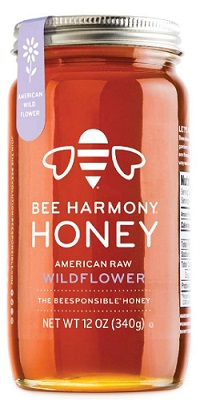
This wildflower honey is lightly fruity but rich at the same time. I love it in my tea and on my toast because it smells amazing and tastes even better. I finished this entire jar of honey in less than four weeks – that’s how I know it’s yummy.
5 Incredible Benefits From Multiple Types of Honey
Some types of honey – like buckwheat honey and manuka honey – are rich in antioxidants. Other types of honey come with incredible antibacterial benefits that make them a good choice for wound healing.
So here’s the thing:
We can’t possibly cover all the types of honey in one article, but we can cover the basic benefits of eating honeycombs and honey.
Here are a few benefits of adding honey to your diet:
- Raw and unfiltered honey is rich in antioxidants and minerals, so you get nutrients from eating it.(29, 30, 31)
- There are many different types of honey for skin care. This is because honey speeds up the wound healing process due to being anti-inflammatory and antimicrobial.(32, 33)
- Eating honey can soothe a cough and sore throat, according to a study of more than 300 children.(34)
- Honey improves cholesterol, which is a strong risk factor for heart disease.(35, 36, 37, 38)
- Honey contains antioxidants that can lower your blood pressure.(39, 40, 41)
Now that brings us to our next question…
How Many Types of Honey Are There?
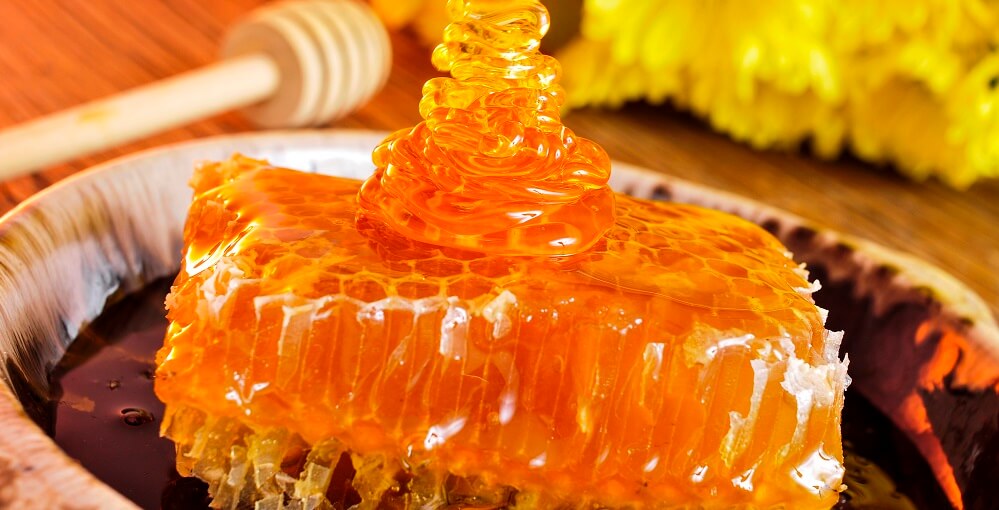
Remember:
There are more than 300 unique varieties of honey.(42)
And besides the three most popular types of honey (clover, manuka, and wildflower) there are many other types of honey in the USA and other countries.
Here are 24 more different types of honey flavors:
- Acacia Honey
- Alfalfa Honey
- Aster Honey
- Avocado Honey
- Basswood Honey
- Beechwood Honey
- Blackberry Honey
- Blueberry Honey
- Bluegum Honey
- Buckwheat Honey
- Coffee Honey
- Dandelion Honey
- Fireweed Honey
- Heather Honey
- Ironbark Honey
- Jarrah Honey
- Leatherwood Honey
- Macadamia Nut Honey
- Orange Blossom Honey
- Palmetto Honey
- Pine Tree Honey
- Sourwood Honey
- Sage Honey
- Tupelo Honey
Acacia Honey
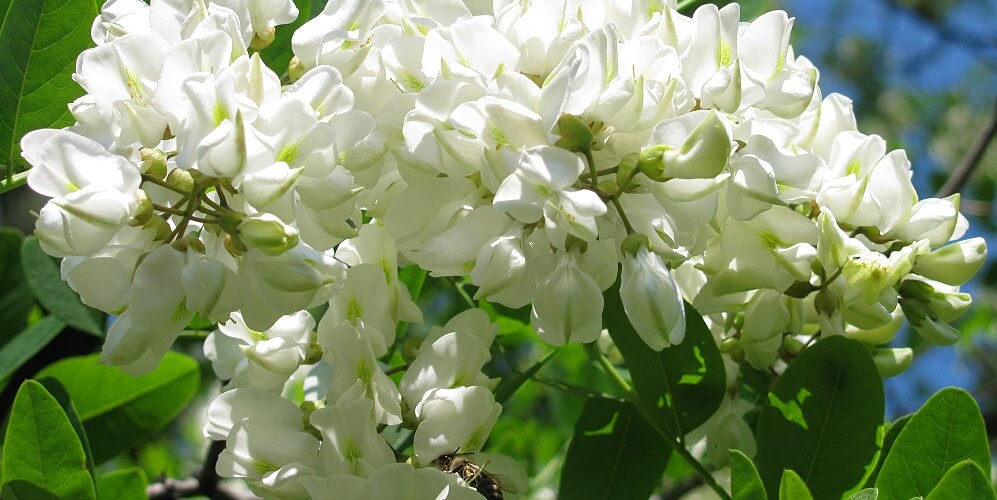
Acacia honey comes from bees who pollinate the black locust tree, or Robinia pseudoacacia. The black locust tree is native to North America and Europe.
This type of honey has a floral aroma and sweet, soft flavor. It has just a whisper of vanilla and almost no aftertaste. You’ll find that this honey mixes well with various types of food.
Acacia honey has a very light, almost transparent golden color.
Where to buy: Bee Harmony’s Acacia Honey from Amazon
—> Click here to go back to the types of honey
Alfalfa Honey
Alfalfa honey comes from bees who pollinate alfalfa plants, also called Medicago sativa. This type of honey is primarily produced in Canada and United States.
This type of honey crystallizes quickly but that doesn’t mean it’s gone bad. You can learn how to decrystallize honey in three easy steps.
Alfalfa honey has a mild sweetness to it, with slight undertones of grass and vanilla. It’s a good choice for baking or eating straight from the jar.
The color ranges from white to extra light amber.
Where to buy: Sandt’s Alfalfa Honey from Amazon
—> Click here to go back to the types of honey
Aster Honey
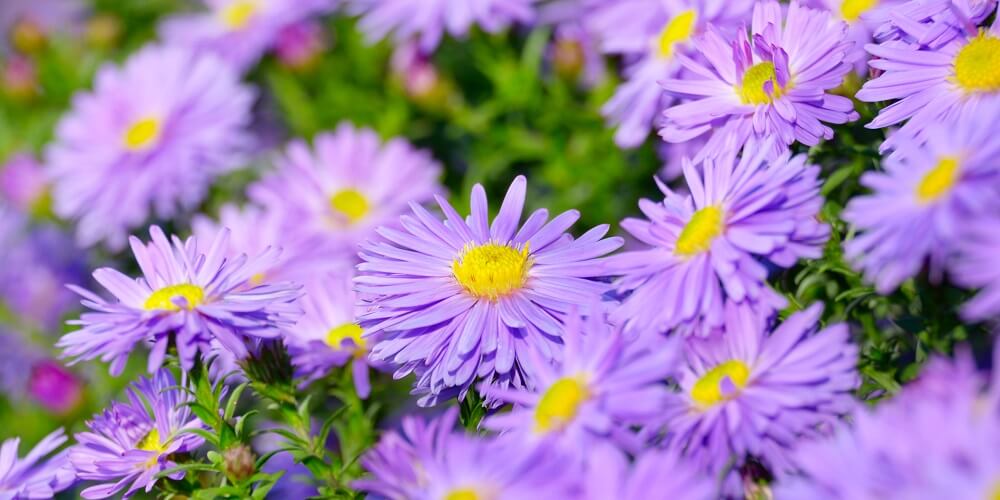
Aster honey comes from bees who pollinate aster flowers. It comes from the mid-south region of the United States. Aster honey is especially prominent east of the Mississippi River.
This type of honey has a smooth and thick consistency with a sweet taste.
Aster honey ranges from light amber to medium amber.
Where to buy: Bright Raven Farm’s Aster Honey
Related: Does Honey Go Bad or Expire?
—> Click here to go back to the types of honey
Avocado Honey
Avocado honey comes from bees who pollinate avocado blossoms. It originates from southern Mexico, Central America, Australia, and California.
Despite its name, this type of honey doesn’t taste like avocados. It has a rich, buttery taste that’s unique. It tastes like molasses without the bitterness. The flavor is strong but not overpowering which makes it a great choice for baking.
Avocado honey is considered a dark honey because it’s a deep, rich amber.
Where to buy: Gideon Spring’s Avocado Honey from Amazon
—> Click here to go back to the types of honey
Basswood Honey
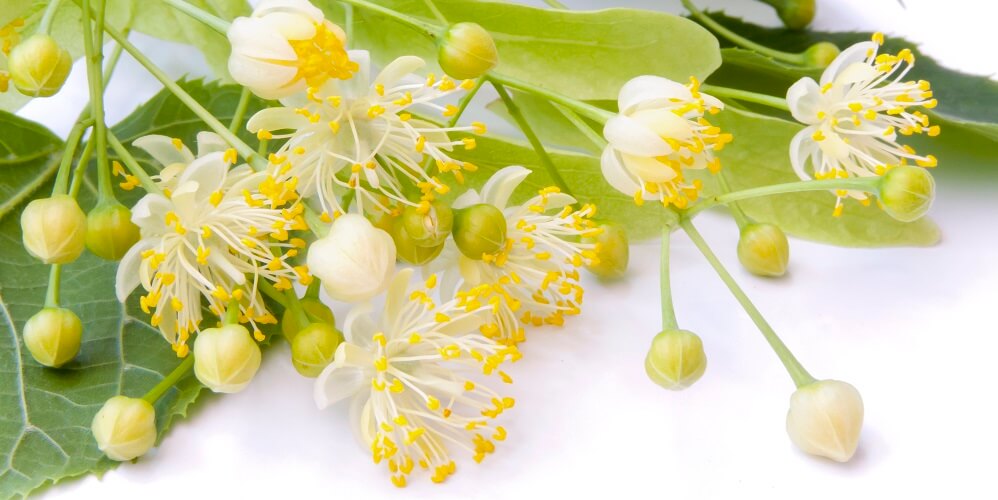
Basswood honey comes from bees who pollinate the basswood tree, also called an American Linden. These tree blossoms are highly fragrant, which helps to attract the bees.
The flavor is a medium sweetness and lightly fruity, with a hint of mintiness. It’s a good choice for salad dressings and marinades.
Generally, this type of honey has a nice, warm golden color. But it can range in color from white to light amber.
Where to buy: Breitsamer’s Linden (aka Basswood) Honey from Amazon
—> Click here to go back to the types of honey
Beechwood honey
This type of honey comes from beechwood trees, primarily found in New Zealand. It comes from the sap produced by insects on the tree’s bark and is later gathered by the bees.
Beechwood honey has a distinctive, sweet taste. It has a silky texture with hints of berries, nectar, and caramel.
This type of honey has a dark color with reddish hints.
Where to buy: Wedderspoon’s Beechwood Honey from Amazon
—> Click here to go back to the types of honey
Blackberry Honey
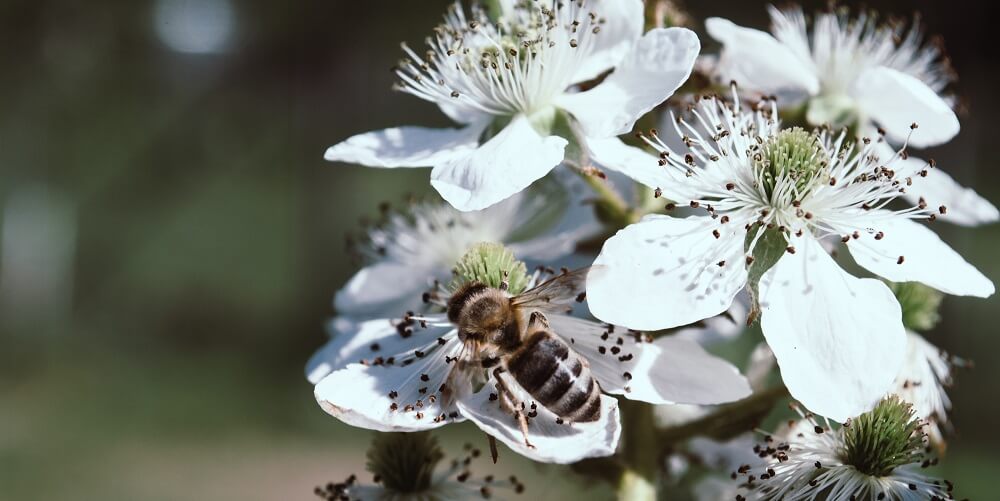
Blackberry honey comes from bees who pollinate blackberry bushes. It’s produced mainly in North America and Europe.
It has a strong flavor that compliments marinades, glazes, and even BBQ sauces. It has a berry taste with a smooth, long-lasting sweetness to it.
This type of honey ranges in color from medium to dark amber.
Where to buy: Glorybee’s Blackberry Honey from Amazon
—> Click here to go back to the types of honey
Blueberry Honey
Blueberry honey comes from bees who pollinate blueberry flowers. This type of honey can be tricky to find because it’s produced in small regions. Blueberry plants require cooler climates to flourish.
That’s why most blueberry honey comes from New England (Maine is the most popular) and central Michigan. That said, other states like New Jersey, North Carolina, and Oregon also produce blueberry honey.
It has a slightly tangy flavor profile with a light blueberry aftertaste. It pairs well with salads and cheeses.
This type of honey has a light to medium amber color.
Where to buy: Bee Harmony’s Blueberry Honey from Amazon
—> Click here to go back to the types of honey
Bluegum Honey
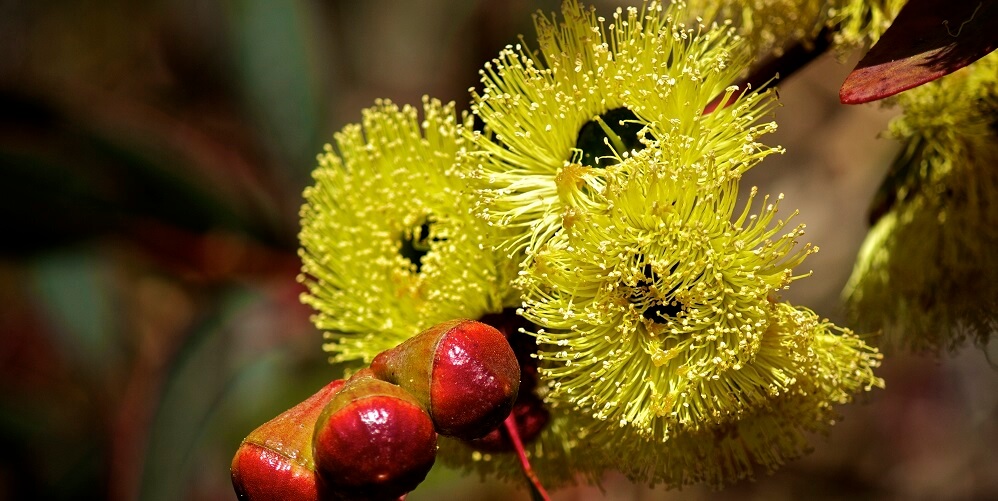
Bluegum honey is also known as eucalyptus honey. It comes from bees who pollinate eucalyptus trees. It’s commonly found in Australia, South Africa, and Brazil.
Bluegum honey has a mild taste which makes it a safe bet for new honey enthusiasts. It has a medium sweetness with an earthy undertone. It also has a hint of butterscotch flavor.
This type of honey has a light to medium amber color.
Where to buy: Gideon Spring’s Eucalyptus Honey from Amazon
—> Click here to go back to the types of honey
Buckwheat Honey
Buckwheat honey comes from bees who pollinate buckwheat flowers. It’s primarily produced in North America, especially in Ohio, Pennsylvania, and New York.
Buckwheat honey’s taste has been compared to many things – coffee, molasses, and even a hint of caramel. I’d describe it as a mix between slightly sweet and slightly nutty.
This type of honey has a rich color. It ranges from dark amber to black. Some people compare the color of buckwheat honey to molasses.
Where to buy: Sandt’s Buckwheat Honey from Amazon
—> Click here to go back to the types of honey
Coffee Honey

Coffee honey comes from bees who pollinate coffee trees. It’s commonly imported from coffee farms in Guatemala and South America.
It has a medium sweetness with a hint of caramel and fruitiness. It contains a little bit of caffeine and goes perfectly in your morning coffee.
This type of honey varies in color from light golden to medium amber.
Where to buy: Smiley Honey’s Coffee Blossom Honey
—> Click here to go back to the types of honey
Dandelion Honey
Dandelion honey is produced from bees collecting and processing dandelion nectar into honey. It’s native to Europe and Asia, but it’s imported into North and South America, South Africa, New Zealand, Australia, and other places.
This type of honey has a strong flavor with medium sweetness. Some people would consider the taste to be pungent with a bitter aftertaste.
Dandelion honey ranges from a deep golden yellow to white.
Where to buy: Goshen’s Dandelion Honey from Amazon
—> Click here to go back to the types of honey
Fireweed Honey

Fireweed honey comes from bees who pollinate fireweed plants. This plant is found in the Pacific Northwest, Alaska, and Canada.
This type of honey has a sharp, almost peppery flavor. The aftertaste is smooth and not overly sweet. It’s much milder than most commercial honey.
Fireweed honey ranges from light amber to almost clear in color. Sometimes you’ll see fireweed honey with a slight green tint, depending on the source.
Where to buy: Moonshine’s Fireweed Honey on Amazon
—> Click here to go back to the types of honey
Heather Honey
Heather honey comes from bees who pollinate the heather plant. This plant is most commonly found in Scotland. But it’s also found in Northern Ireland and Britain.
It has a thick consistency and powerful taste. It’s a mix between fruity and woodsy, with a tangy aftertaste. The sweetness is mild.
This type of honey has a dark amber color with a red or orange tint.
Where to buy: Raw Heather Honey from Etsy
—> Click here to go back to the types of honey
Ironbark Honey
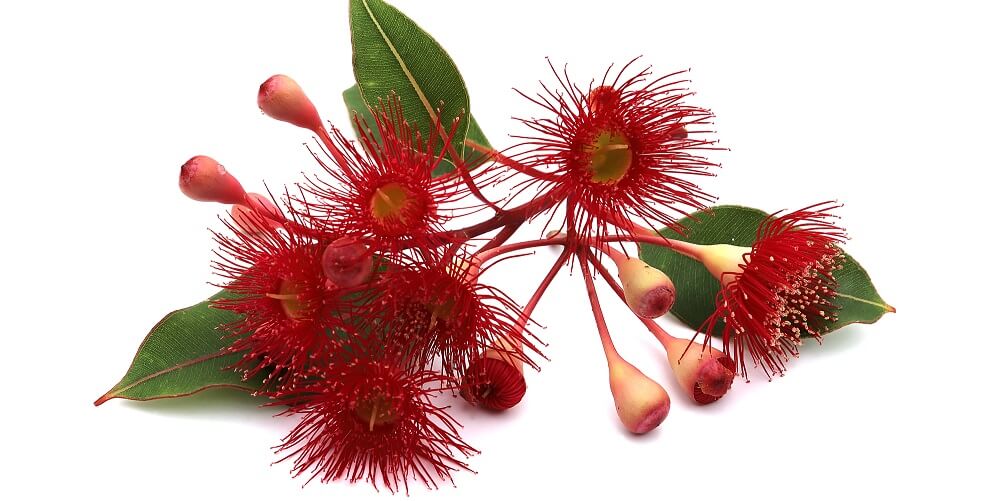
Ironbark honey comes from bees who pollinate Australian ironbark trees. These trees are unique to Australia.
This type of honey has a mild sweet yet distinctive taste. It has a smooth texture that melts in your mouth. It compliments barbecued meats well.
Ironbark honey has a light, golden color.
Where to buy: Gustare’s Ironbark Honey from Amazon
—> Click here to go back to the types of honey
More to Explore:
Jarrah Honey
Jarrah honey comes from bees who pollinate jarrah trees. This type of honey is unique to Western Australia.
Jarrah honey has a sweet, caramel flavor that’s delicious. Some people say it has a hint of nuttiness to it. It’s a nice topping for granola, yogurt, and ice cream.
It ranges in color from medium to dark amber.
Where to buy: Raw Jarrah Honey from Etsy
—> Click here to go back to the types of honey
More to Explore:
Leatherwood Honey
Leatherwood honey comes from bees who pollinate the leatherwood blossom. This honey is produced only in Tasmania, Australia.
This type of honey is known for its unique flavor. It’s lightly spicy with a clean, fresh, balsamic hint to it. It’s buttery and melts in your mouth.
Leatherwood honey has a medium yellow to orange color.
Where to buy: Tasmanian Leatherwood Honey from Amazon
—> Click here to go back to the types of honey
More to Explore:
Macadamia Nut Honey
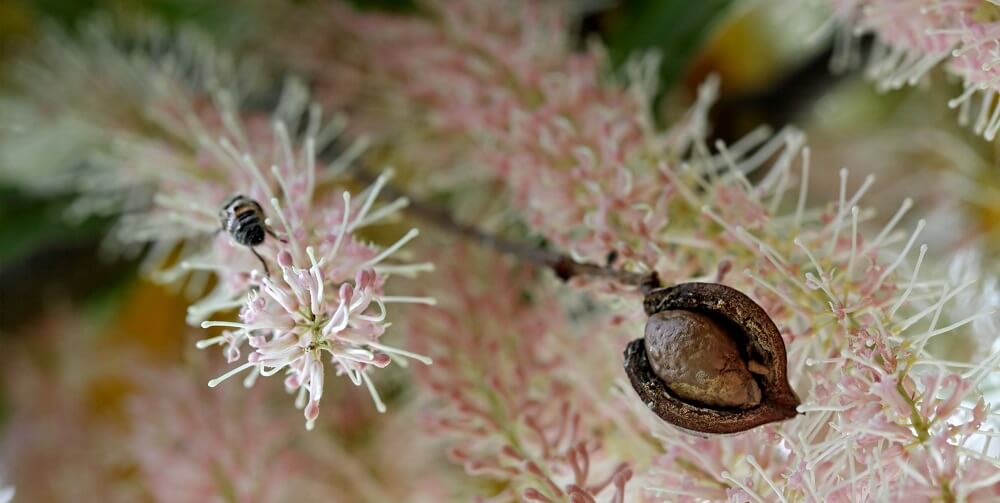
Macadamia nut honey comes from bees who pollinate macadamia trees. These trees are common in Australia and Hawaii. In fact, Hawaii is the world’s largest producer of macadamia honey.
This type of honey has a silky texture, with hints of chocolate, citrus, and sweet nuttiness thrown in. It’s delicious drizzled onto food because of its sweetness.
Macadamia honey ranges in color from light to dark amber.
Where to buy: Big Island Bee’s Macadamia Honey from Amazon
—> Click here to go back to the types of honey
More to Explore:
Orange Blossom Honey

Orange blossom honey comes primarily from bees who pollinate orange trees. Orange blossom honey is made in Florida, Southern California, and parts of Texas.
This type of honey has a light citrus taste and smell. It pairs well with breakfast foods like toast, bagels, and English muffins.
Orange blossom honey ranges in color from white to light amber.
Where to buy: Bee Harmony’s Orange Blossom Honey from Amazon
—> Click here to go back to the types of honey
More to Explore:
Palmetto Honey
Palmetto honey comes from bees who pollinate Serenoa repens, a short palm tree topped by huge fan-shaped leaves. This palm tree is commonly found in Georgia, Alabama, Louisiana, and South Carolina.
This type of honey has a smoky, woody flavor with citrus tones. It even has a hint of caramel in it. The boldness and complex flavor make it a great choice with savory foods and cheese.
Palmetto honey ranges in color from light to deep amber.
Where to buy: McCoy’s Palmetto Honey from Amazon
—> Click here to go back to the types of honey
More to Explore:
Pinetree Honey
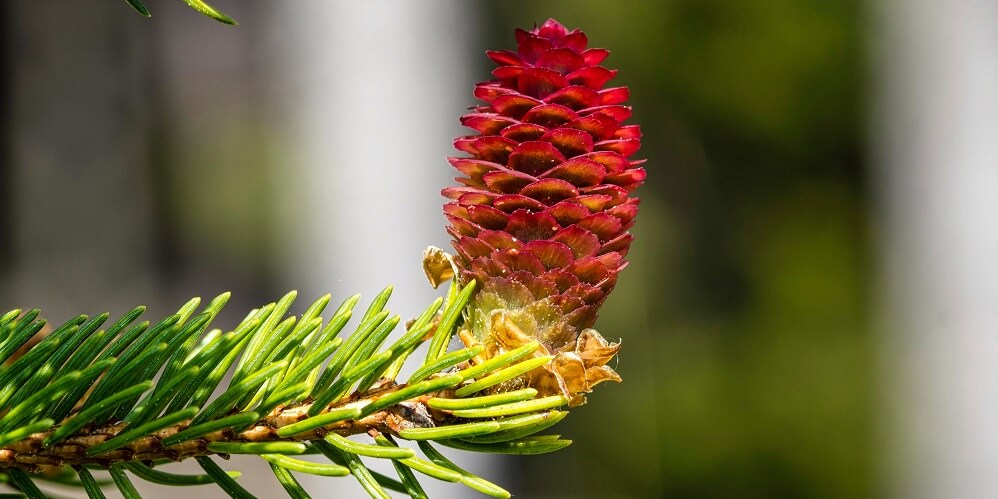
Pinetree honey is also called honeydew honey. It comes from bees who collect honeydew from an insect called Marchalina hellenica, which lives on the sap of some pine trees.
It’s found in heavily forested areas of the United States, Norway, Italy, Germany, and New Zealand. But, it’s primarily produced in the pine forests found in the Mediterranean.
This type of honey is a combination of sweet and spicy. It has some woody notes without a harsh aftertaste.
It varies in color from light gold to dark amber.
Where to buy: Bee and You’s Pine Honey from Amazon
—> Click here to go back to the types of honey
More to Explore:
- Acacia Honey: The Taste, Health Benefits, & Risks
- Do Honey Pasteurization Ruin Honey?
- Allergic to Honey: Signs of a Honey Allergy + Treatment
Sourwood Honey
Sourwood honey comes from bees who pollinate sourwood trees. This type of honey is specific to the United States. It’s primarily found in the eastern mountain regions like the Appalachian mountains in North Carolina, eastern Tennessee, and northern Georgia.
Thankfully, sourwood honey isn’t sour like you might think. It actually has a buttery, sweet, and slightly spicy taste. There are hints of caramel in this honey.
Sourwood honey has a beautiful light amber color.
Where to buy: Bee Wild’s Sourwood Honey from Amazon
—> Click here to go back to the types of honey
More to Explore:
Sage Honey

Sage honey comes from bees who pollinate the sage plant. Most sage honey comes from California.
This type of honey has a soft yet rich, sweet flavor. The aftertaste is slightly floral and the texture is silky and creamy. It pairs well with savory dishes and cheeses.
Most sage honey ranges in color from light amber to golden amber. Some sage honey has a slight greenish tint, depending on where the bees source their plants. Purple sage honey is the exception. It has a very deep purple color that can almost appear black.
Where to buy: Honey Pacifica’s Sage Honey from Amazon
—> Click here to go back to the types of honey
More to Explore:
Tupelo Honey
Tupelo honey comes from bees who pollinate the tupelo gum tree. This type of honey is only produced in two small regions of Florida and Georgia’s swamps.
More specifically, it comes from the Okeefenokee Wildlife Refuge and the Apalachicola River.
Tupelo honey has an amazing flavor profile. In fact, it may be the sweetest honey variety you’ll ever taste. It had a strong fruity-floral burst that catches you by surprise. As it melts in your mouth, it leaves you with a warm finish.
Some people say tupelo honey tastes like Juicy Fruit gum but with a more refined and natural taste. The texture is buttery smooth and goes perfectly drizzled over ice cream.
This type of honey has a light golden amber color with a greenish tint.
Where to buy: Savannah Bee’s Tupelo Honey from Amazon
